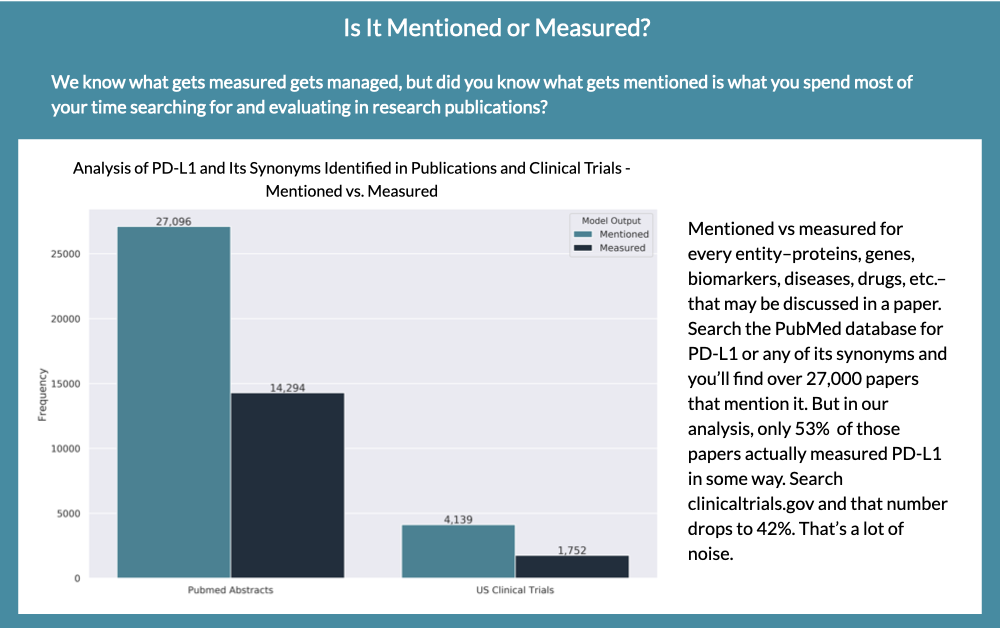Do You Really (Really?) Need Machine Learning for Prospecting?
When was the last time you read a press release about a new biopharma and headed straight to PubMed to investigate their research? Maybe you did a quick keyword search to understand how they’re using PD-L1 and after 30 minutes of reading, you realized that while PD-L1 is mentioned several times as a biological pathway, it’s not the biomarker target you were hoping for. Multiply by that by 20 leads per week and you’ve spent 10 hours of your valuable time investigating dead-end leads.
Traditional life sciences prospecting requires a lot of research, vigilance, and tracking to find companies that match your capabilities at just the right time. Even with the best processes, it is overwhelming and unproductive most of the time. If only you had a way to make sense of it all automatically. That’s where machine learning comes in!
Machine Learning Makes Life Sooooo Much Easier
Remember the early days of search engines? No? Consider yourself lucky! But if you do, you’ll also recall that if you wanted to find something on the burgeoning world wide web (at a time when it was much more web and much less wide) you had to know the exact wording of a website’s “title” to find it. Seriously? Seriously. And search results were a disaster, with lots of noise masking the signal.
Jean Armour Polly, who coined the phrase “surfing the internet” remarked about why she chose surfing as a metaphor: “I wanted something that expressed the fun I had using the Internet, as well as hit on the skill, and yes, endurance necessary to use it well. I also needed something that would evoke a sense of randomness, chaos, and even danger.” Yep. Pretty much sums it up.
Fast forward to the Google search we use today and it’s a vastly different experience. It not only retrieves all information but also ranks it based on what is important to other people and to you. It “knows” you, so it attempts to predict what you’re looking for. What makes the search experience better is the same thing that powers your spot-on Netflix suggestions and helps Alexa and Siri become smarter assistants over time—machine learning.
How Machine Learning Makes Sense of the Biological Revolution
So, we know machine learning is making our lives easier every day and enabling us in ways (and Waze) that just a few years ago seemed miraculous. But it’s also helping us innovate scientific research and medicine, from diagnosis to precision medicine. Machine learning has become critical to understanding the formidable set of biological data—helping to turn millions of scientific discoveries into applications, drugs, and yes, even more biological research.
Machine learning models are developed by applying learning algorithms to specific datasets that “reason” and learn from the data. Machine learning algorithms can learn complex patterns that are hidden even to human domain experts. Computer scientists develop the algorithms to think like we do. So, you can’t read millions of scientific papers or evaluate every clinical trial, but you can get a machine to do it for you. And it helps that the machine now thinks like the world’s largest team of PhDs.
Can I Get an Example?
Sure. How about “mentioned versus measured”? If you’re reading a scientific pub and come across programmed death-ligand 1 (PD-L1), you understand whether the researchers are:
- noting other studies performed on the protein
- referencing a biomarker
- referring to a biological pathway, or
- actually measuring it as an analyte in the experiment.
A simple keyword search of pubs won’t tell you that. You actually have to read each paper to know if it’s relevant to you.
Another problem that machine learning helps overcome in this instance is that of synonyms, or alternate names, for a given entity. Diseases, drugs, proteins, and genes can all have more than one name, which is not usually indicated in the publication or clinical trial itself. PD-L1 is also commonly known as cluster of differentiation 274 (CD274) or B7 homolog 1 (B7-H1). These two synonyms make search even more difficult, but the issue with biological synonyms is they’re usually not confined to one or two alternatives and associated names. For PD-L1, there are more: PDL1, pd-l1, pd -l1, pd- l1, pdl-1, PDL-1, anti PDL1, anti-PDL1, anti-cd274, anti cd274, Pdcd1L1, sc293425, Pdcd 1L1, sc-293425, 293425, CD274, CD274 molecule, B7 H, B7H1, PD L1, PDCD1LG1, and PDL1.
So, searches return everything, whether it’s relevant or not, but also miss a ton of critical information. Kind of like being back on the internet in the ’90s! Alternatively, machine learning models can make sense of these data sets, then filter out the noise to automatically find all of these entities and deliver only relevant information.

Machine Learning Is the Secret to Finding Your Ideal Customers at the Right Time
Every year, millions of research publications, press releases, clinical trials, and other sources of biomedical evidence are published. Each of these sources might signal a new sales or partnership opportunity.
But identifying opportunities that match your ideal customer profile and business objectives in this avalanche of information is too much to do reliably without advanced technology. Even with advanced keyword searches and alerts, qualifying an opportunity requires that you are able to evaluate every detail in context–like whether an entity was actually measured or simply mentioned–and that you have access to insights when they happen.
Today’s data scientists have developed machine learning applications that are trained to match the same level of accuracy as domain experts. Rather than having trained experts review countless documents in hopes of finding something relevant, the right machine learning is able to sort evidence and prioritize those opportunities that are most likely to be a perfect fit.
Machine Learning Gives Life Sciences Sales and Marketing Teams Clarity
Amplion’s core technology is centered around the ability to extract and analyze information from various evidence sources like pubs, clinical trials, and drug labels. It also uses press releases, conference abstracts, and myriad other sources to compile complete profiles for academic, biotech, and pharma organizations. Amplion’s machine learning models rely on the context of the information, whether that context is a place in a structured document or the surrounding text in a block of text, to ensure accuracy and infer meaning.
Training data is used to develop models for each data type in each document type. Training data is created by performing manual annotations—reviewed and approved by a team of trained biomedical experts—aimed at teaching the meaning within each sentence and also throughout the document. Each document is also matched to a list of individual entity synonyms, e.g., sera and serum. Through the manual annotation process, each data type is determined as valid or not relevant. In this way, the machine learning models mimic what people do when they read—they provide context. Context is the key to understanding without having to do the research yourself.
Context is important, not just as it relates to mentioned versus measured, but also regarding the entity type. Plasma or stem cells, for example, can be a sample type used in a research study or could instead be used as a therapy. But which is relevant to your capabilities and ideal customer profile? Mentioned versus measured, synonym matching, and expert context recognition are just a few of the functions that deliver precise, relevant results without the noise.
But wait, there’s more?
Yeah. Here’s what we’re getting at. You specify which attributes are explicitly relevant to you and machine learning evaluates the context so that it can automatically surface your matching opportunities. It instantly makes sense of a universe of information that is beyond your ability to manage, learn, or even explore in a meaningful way. It consolidates everything into a set of actionable insights you can use to grow your marketing and sales engagement and drive more revenue by finding the right opportunities at the right time.
Find out how machine learning can amp up your sales and marketing results.
Want to upgrade your prospecting and lead gen processes for the better (and for good)?
Establishing best practices for your sales and marketing team’s day-to-day prospecting and lead gen workflows can
help everyone on your team achieve rockstar results.


